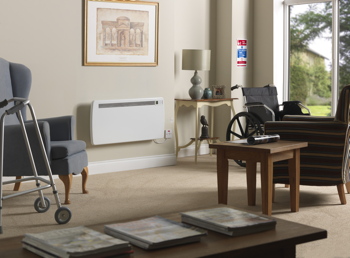Electric heating in non-domestic buildings — the path to Part L
Despite increasingly stringent carbon-reduction targets, achieving Part L compliance with electric heating in non-domestic buildings remains viable and can deliver significant benefits. Chris Stammers of Dimplex explains how.
Electric space heating currently represents around 10% of the UK’s domestic-heating market, a figure which is on the rise due to ever-decreasing peak heating loads and changing housing construction trends encouraging the use of electric heating in the development of new flats and apartments. From direct-acting and energy-storage solutions, to innovative storage heaters with high heat retention, electric appliances continue to deliver viable, cost-effective heating for many households. But it is not just restricted to private domestic dwellings. Hotels, small offices, care homes and student accommodation blocks are all well suited to this technology.
There are a number of reasons for this continued appeal. Aside from not requiring a gas connection, electric heating systems offer a lower capital expenditure (capex) build, with no need for heating pipework, boiler plant or heat metering required. As a result, when specified correctly, electric heating can be the most effective solution for a wide range of non-domestic properties with low energy consumption.
Any heating system requires careful consideration, and electric systems are no different — especially when it comes to meeting Building Regulations. In particular, it is important to understand the impact that the heating choice can have on the carbon rating of a building. The National Calculation Methodology is currently used to determine CO2 emissions for new non-domestic buildings in compliance with Part L of the Building Regulations. It is also used to generate Energy Performance Certificates for non-domestic buildings under construction and at the point of sale or rent.
The first thing to understand is, despite electricity being an expensive fuel with high carbon factor does not mean it is not viable. Too many installers and energy managers are quick to disregard direct-acting electric heating because of its CO2 emissions factor, but with a long list of benefits throughout the design, installation and operation phases, it should not be ruled out without closer inspection.
Clearly electric heating is particularly appropriate, and is very often the default option for smaller buildings with low energy requirements, ensuring that the bills are kept low and manageable and that the overall carbon impact on the build is minimised. This would also ensure that fewer heaters are needed, enabling the power consumption to be reduced.
Multi-occupancy buildings such as student accommodation are a great example. Individual rooms have low heat losses and pipework and metering would make some other systems difficult and costly to install. Direct-acting electric panel heaters, for example, offer 100% efficiency at point of use, with no need for metering but with individual controls for each heater — something that cannot be ignored in multi-occupancy buildings or small offices where rooms are often not in use.
The challenge of course, and why too many people wrongly look past electric heating, is ensuring compliance with Part L. However, in many cases there is a simple solution. With a little bit of help from a renewable-energy system such as solar PV to boost the building’s energy rating, it can not only meet the requirements of Building Regulations, but also deliver all the benefits of electric heating for architects, developers, contractors and occupants. And solar PV, of course, is by no means a risky or untested solution — and has significant cost and environmental benefits of its own.

There are occasions when available space for PV can come at a premium and with deployment severely limited compared to levels of occupancy, the options for PV can be dramatically reduced. In such cases renewables alternatives, such as heat pumps, have a greater role to play.
As insulation specifications improve, the power requirements for heating in non-domestic buildings have been significantly reduced in comparison to other services, especially water and lighting.
For those seeking to reduce carbon emissions from their building addressing the hot-water system is a good place to start. As a response to this need Dimplex is introducing its EDL hot-water heat pumps as a lower-carbon alternative to electric immersion heaters. Hot-water heat pumps use a high-performance compressor to extract energy from the external air. Using up to three times less electricity than direct-acting water heaters, they provide an energy-efficient hot-water solution for electrically heated, managed properties such as healthcare, retirement living, social housing and student accommodation.
A combination of approaches to address both electric heating and hot water means achieving Part L compliance in non-domestic buildings is not only viable, but can deliver really significant benefits.
Chris Stammers is product-marketing director at Dimplex.








